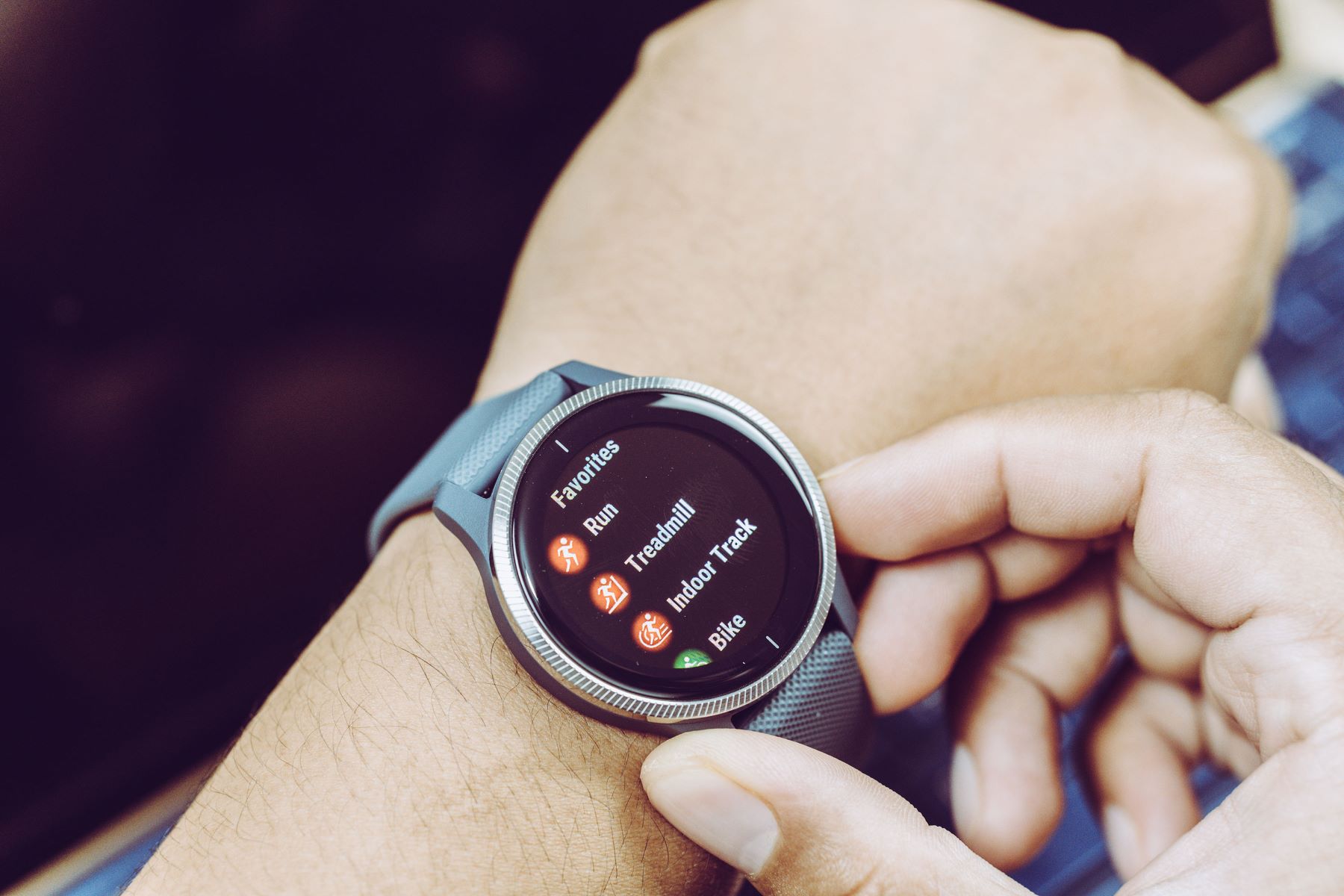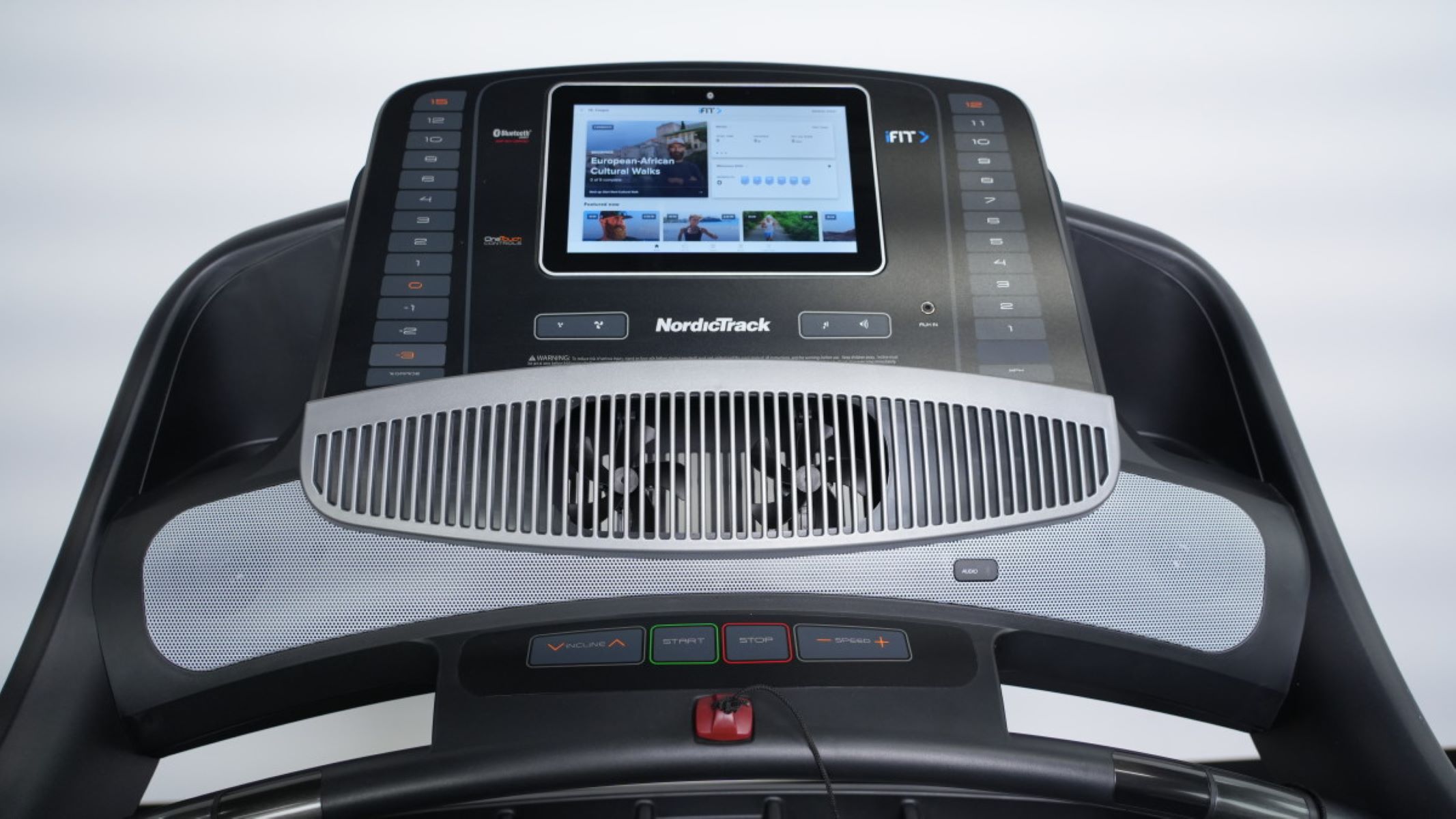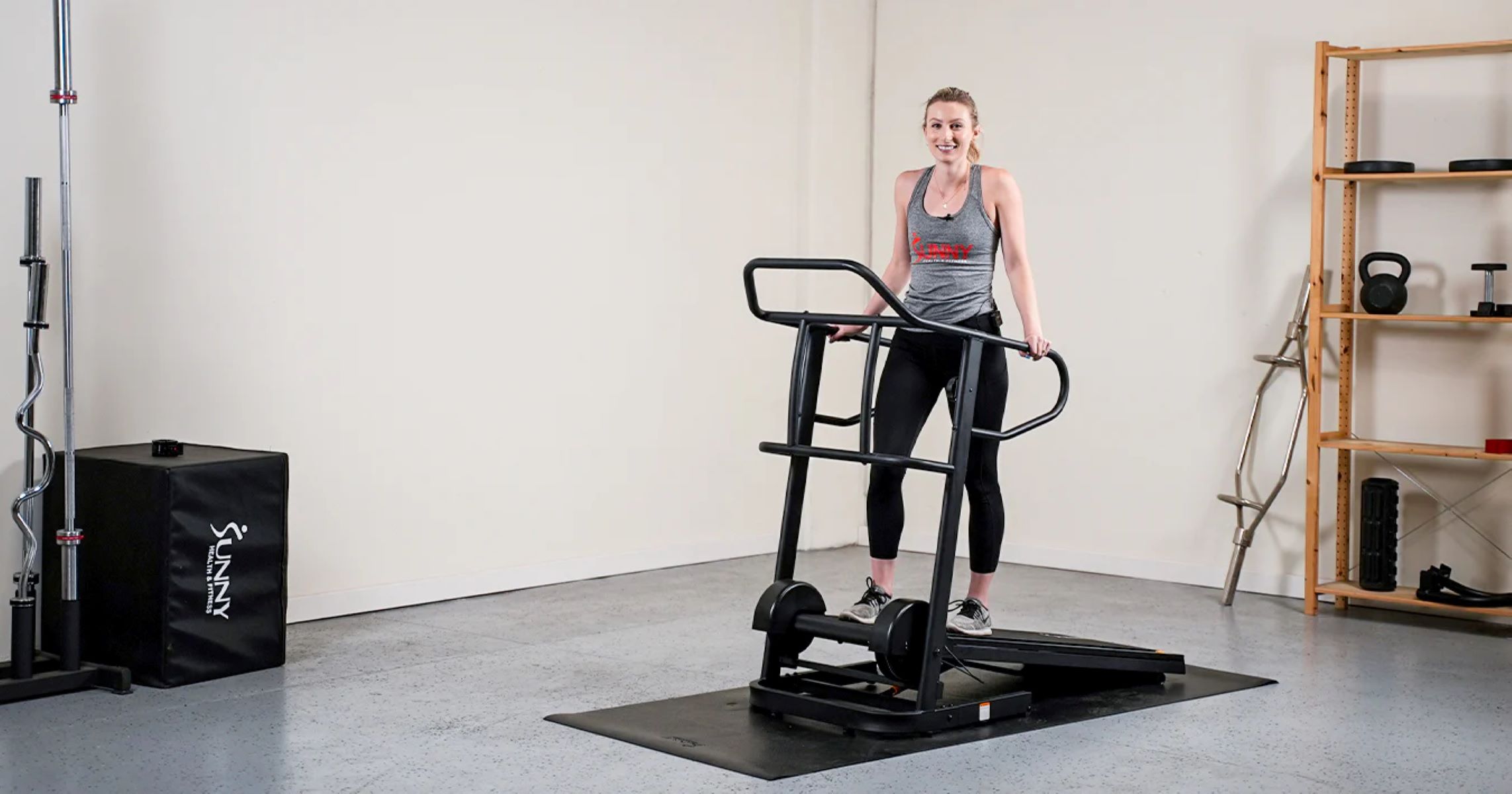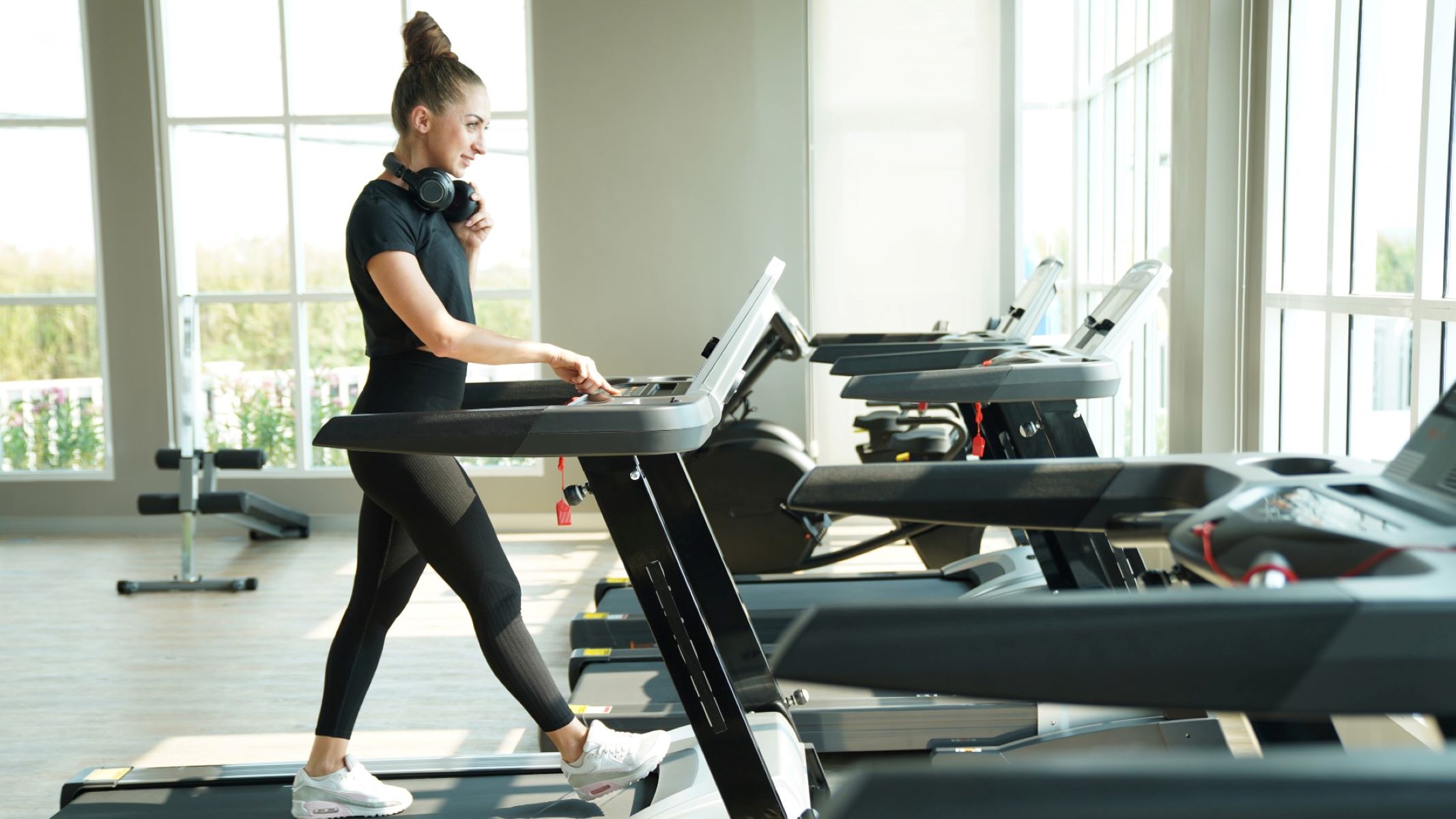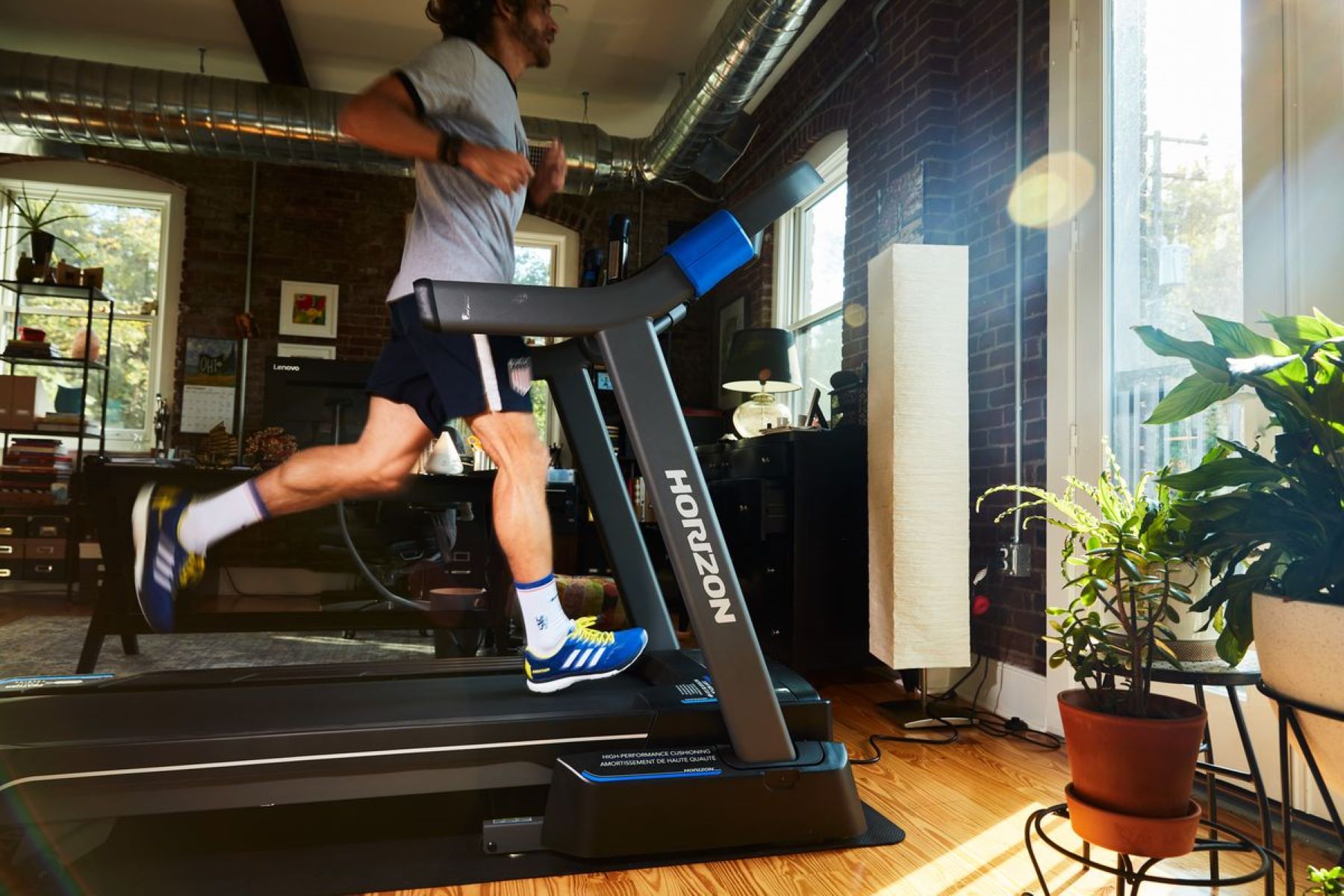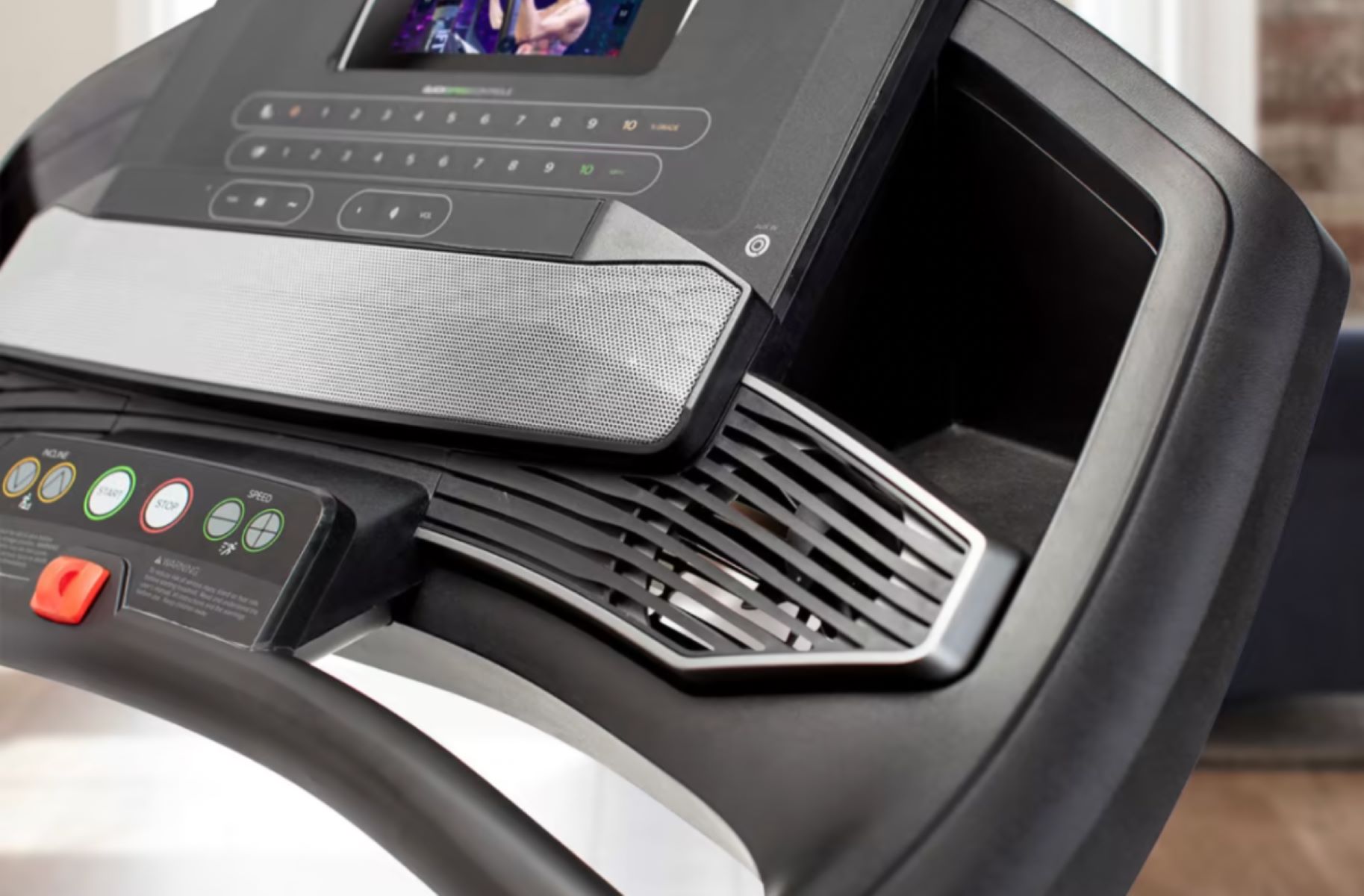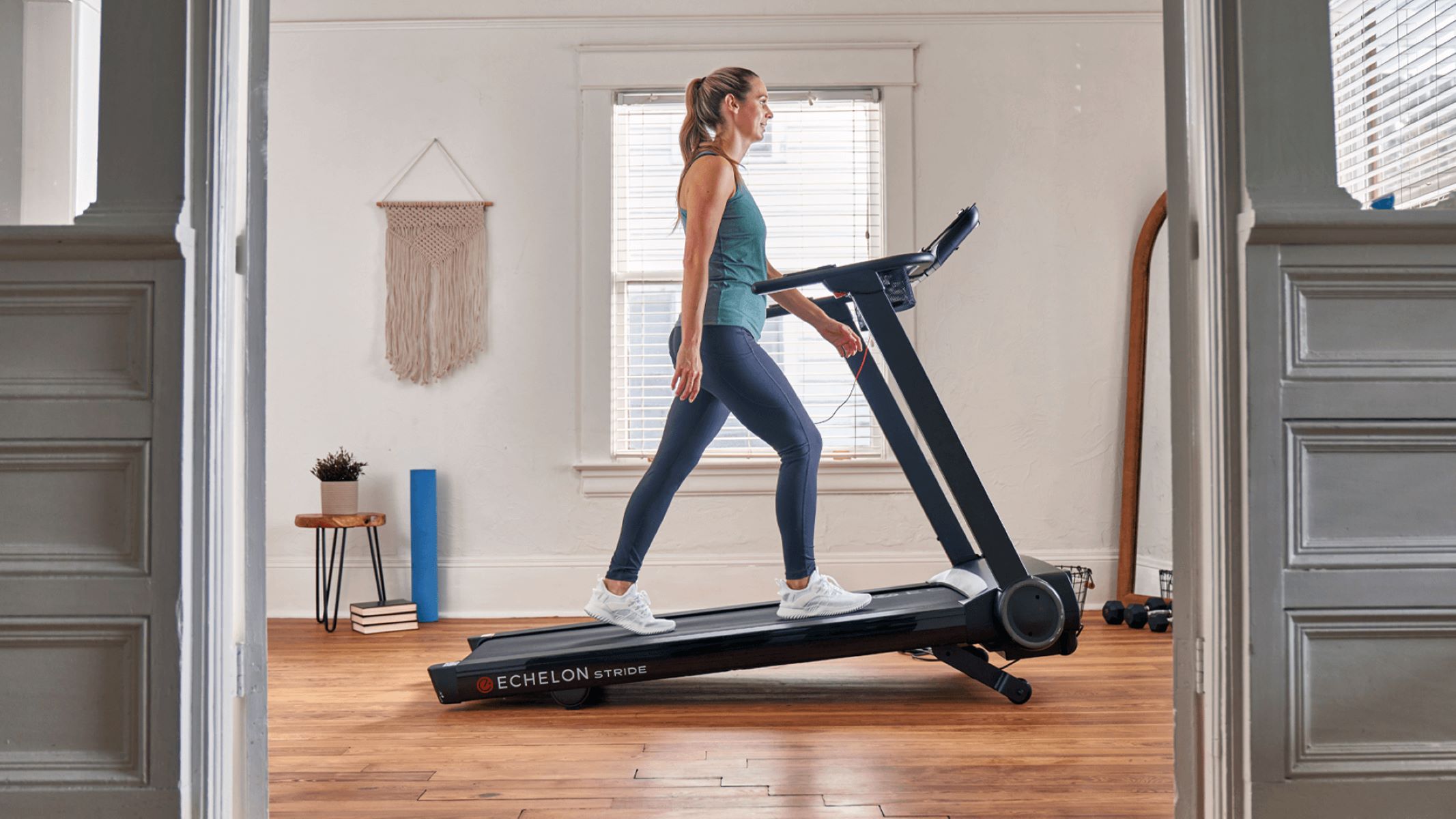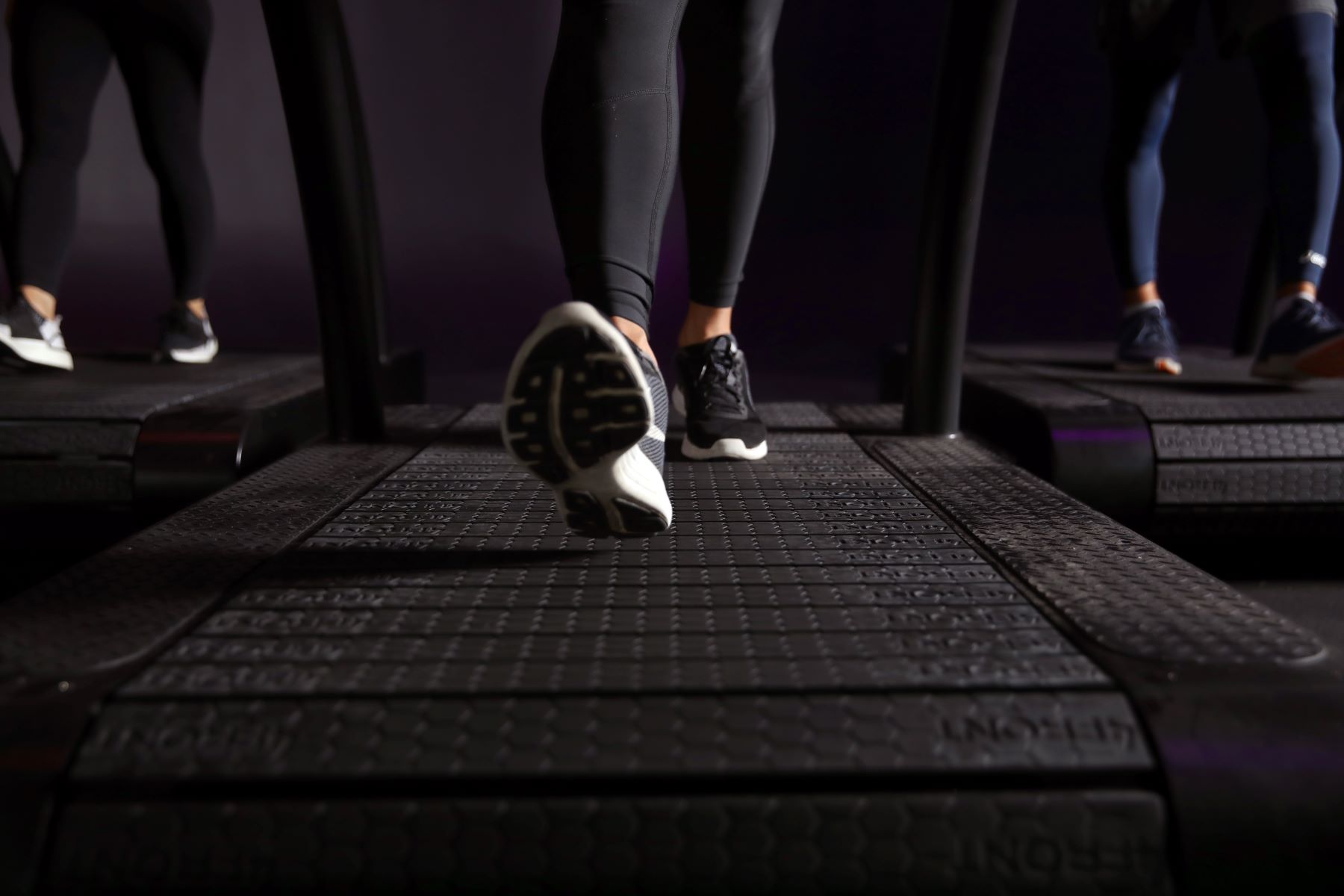

Featured
How To Train On Treadmill
Modified: May 22, 2024
Learn effective ways to train on a treadmill with our featured guide. Maximize your workout potential and achieve your goals with these expert tips.
Introduction
Welcome to the wonderful world of treadmill training! Whether you’re a seasoned runner looking to switch up your routine or a beginner wanting to start your fitness journey, the treadmill can be a valuable tool to help you achieve your goals. With its adjustable settings and convenience, the treadmill provides a versatile option for cardiovascular exercise that can be tailored to your specific needs.
Training on a treadmill offers a host of benefits. You have control over the speed, incline, and duration of your workout, allowing you to customize your training program to match your fitness level and objectives. The cushioned surface of the treadmill also reduces the impact on your joints, making it a safer option than running on hard pavement.
Not only does treadmill training improve your cardiovascular endurance, but it can also help you burn calories and shed those extra pounds. Whether your goal is weight loss, improved fitness, or simply to boost your mood and overall well-being, the treadmill can be an effective tool in achieving these outcomes.
In this article, we will walk you through the essential steps to train effectively on a treadmill. From choosing the right treadmill to incorporating interval training into your routine, we will provide you with all the information you need to make the most out of your treadmill workouts. So, lace up your shoes, step on the treadmill, and let’s get started on your journey to a fitter, healthier you!
Choosing the Right Treadmill
When it comes to selecting a treadmill, there are a few key factors to consider that will ensure you find the perfect fit for your needs. By taking the time to evaluate these factors, you can make an informed decision and invest in a treadmill that will support your training goals for years to come.
The first and most crucial consideration is the treadmill’s motor. Look for a treadmill with a powerful and durable motor that can handle your intended usage. A motor with a higher horsepower will provide smoother, more consistent performance, especially during intense workouts or when running at higher speeds. Aim for a motor with a minimum of 2.5 horsepower for walking and 3.5 horsepower for running.
Next, take into account the treadmill’s size and weight capacity. Ensure that the running deck is long and wide enough to accommodate your stride length comfortably. A standard treadmill deck is about 55-60 inches long and 20-22 inches wide. If you’re taller or have a longer stride, consider a treadmill with a longer deck to avoid feeling cramped.
Additionally, pay attention to the treadmill’s weight capacity. It’s crucial to choose a treadmill that can support your weight to ensure stability and longevity. Consider your current weight and any potential weight you might gain as you progress in your fitness journey.
Another factor to consider is the treadmill’s incline capabilities. Most treadmills offer adjustable incline settings, allowing you to simulate uphill running or walking. This feature can significantly enhance your workout by increasing the intensity and engaging different muscle groups. Look for a treadmill with incline options that align with your fitness goals.
Finally, consider additional features that can enhance your treadmill training experience. These may include built-in workout programs, heart rate monitoring, Bluetooth connectivity, compatibility with fitness apps, and entertainment options like a built-in screen or speakers. While these features are not essential, they can make your workouts more enjoyable and provide additional workout guidance.
By carefully considering these factors, you can choose a treadmill that meets your specific needs and allows you to achieve your fitness goals. Take the time to research different models, read reviews, and test out treadmills in person if possible. Investing in the right treadmill will not only make your training more effective but also more enjoyable in the long run.
Setting Up the Treadmill
Now that you’ve chosen the perfect treadmill, it’s time to set it up for your workouts. Proper setup is essential for safety and optimal performance. Follow these steps to ensure your treadmill is ready to go:
- Find a suitable location: Choose a dedicated space in your home or gym for your treadmill. Ensure that the area is well-ventilated and has sufficient clearance around the sides and back of the treadmill for safety.
- Read the manual: Familiarize yourself with the manufacturer’s instructions and guidelines by reading the user manual carefully. Pay attention to any specific setup requirements, maintenance instructions, and safety precautions.
- Assemble the treadmill: If your treadmill requires assembly, follow the provided instructions to put it together correctly. Take your time to ensure that all parts are securely tightened for stability.
- Adjust the incline: Set the treadmill’s incline to the flat or zero position to start. You can gradually increase the incline as you become more comfortable and build strength.
- Ensure proper power supply: Plug your treadmill into a grounded outlet and make sure the power cord is securely connected. Avoid using extension cords or power strips to prevent voltage issues.
- Check the safety features: Ensure that the treadmill’s emergency stop button or safety clip is easily accessible and in working order. Familiarize yourself with how to use it in case of an emergency.
- Adjust the treadmill settings: Set the display language, units of measurement, and any desired personalized settings on the treadmill console.
- Calibrate the treadmill: Some treadmills may require calibration to ensure accurate speed and distance readings. Follow the manufacturer’s instructions on how to perform calibration if necessary.
- Test the functions: Before hopping on your treadmill for a workout, take a few moments to test the various functions, such as speed adjustment, incline control, and workout program options.
By carefully following these steps, you can set up your treadmill correctly and ensure a smooth and safe workout experience. Take the time to get familiar with your treadmill’s features and functionality before diving into your training sessions. Now that your treadmill is ready to go, it’s time to start warming up and stretching before getting into your workout routine!
Warming Up and Stretching
Before you dive into your treadmill workout, it’s important to properly warm up your body and engage in stretching exercises. This will prepare your muscles and joints for the upcoming physical activity, reduce the risk of injury, and improve your overall performance. Follow these steps to effectively warm up and stretch before getting on the treadmill:
- Start with a brisk walk: Begin by walking at a comfortable pace on the treadmill for 5-10 minutes. This will gradually increase your heart rate and warm up your muscles.
- Incorporate dynamic stretches: After your warm-up walk, perform dynamic stretching exercises to further loosen up your muscles. These stretches involve moving your body through a controlled range of motion. Examples include leg swings, arm circles, walking lunges, and high knee marches.
- Focus on major muscle groups: Pay particular attention to stretching the major muscle groups that will be engaged during your treadmill workout. This may include your calves, quadriceps, hamstrings, hip flexors, and upper body muscles. Hold each stretch for 15-30 seconds and repeat on both sides.
- Include mobility exercises: Incorporate mobility exercises to improve joint range of motion. This can involve shoulder rolls, neck rotations, hip circles, and ankle rotations. These exercises help promote better movement patterns and reduce stiffness.
- Avoid static stretching: It’s important to note that static stretching, where you hold a stretch for an extended period, is best done after your workout. Save static stretching for your post-workout cooldown to promote flexibility and prevent muscle tightness.
Remember to listen to your body and work within your comfort levels when performing warm-up exercises and stretches. Focus on proper form and avoid bouncing or pushing yourself too hard. Gradually increase the intensity of your warm-up as your body starts to feel more engaged and ready for your treadmill workout.
Warming up and stretching is a crucial part of any exercise routine, including treadmill training. It not only prepares your body physically but also mentally, helping you to get in the right mindset for an effective and enjoyable workout. By incorporating these warm-up and stretching exercises into your treadmill routine, you’ll optimize your performance and minimize the risk of injuries.
Basic Treadmill Techniques
Now that you’re warmed up and ready to hit the treadmill, it’s time to learn some basic techniques to make the most out of your workout. Whether you’re a beginner or an experienced runner, these tips will help you maximize the effectiveness and enjoyment of your treadmill training:
- Stand upright and maintain proper posture: When running or walking on the treadmill, make sure to stand tall and maintain a good posture. Keep your shoulders relaxed, your head up, and your gaze forward. Avoid leaning forward or slouching, as this can put unnecessary stress on your joints and lead to discomfort.
- Land softly and use a natural stride: Aim to land softly on the treadmill with each step. Avoid pounding your feet down, which can increase the risk of injuries. Find a stride length that feels comfortable and natural for you, allowing your feet to strike the treadmill belt directly under your body.
- Pay attention to your foot placement: Try to strike the treadmill belt with your midfoot or forefoot, rather than landing on your heels. This promotes a more efficient and smoother running or walking motion. Avoid overstriding, which means taking excessively long steps, as it can cause strain on your muscles and joints.
- Stay centered on the treadmill: Position yourself in the middle of the treadmill belt to maintain balance and prevent unnecessary stress on one side of your body. Make sure your feet are aligned with your hips, and avoid leaning to one side or favoring one leg.
- Use the handrails sparingly: While the handrails on the treadmill can provide stability, it’s best to minimize your reliance on them. Engage your core muscles and allow your arms to swing naturally to maintain balance. Only hold onto the handrails lightly when necessary, such as during intense workouts or when adjusting the treadmill settings.
- Experiment with speed and incline: Take advantage of the adjustable settings on the treadmill to vary your workouts. Gradually increase or decrease the speed to challenge yourself, and adjust the incline to simulate uphill or downhill running. This allows you to work different muscle groups, increase the intensity, and add variety to your routine.
- Stay hydrated: Keep a water bottle nearby and sip water throughout your workout to stay properly hydrated. Even though you may not feel as thirsty as you would during outdoor workouts, it’s important to replenish fluids to maintain optimal performance.
By practicing these basic treadmill techniques, you’ll not only improve your running or walking form but also enhance your overall treadmill training experience. Remember to start at a comfortable pace and gradually increase the intensity and duration of your workouts as your fitness level improves. Keep challenging yourself, but always listen to your body and make adjustments as needed to ensure a safe and effective workout.
Incorporating Interval Training
If you’re looking to take your treadmill workouts to the next level, incorporating interval training can be a game-changer. Interval training involves alternating between periods of high-intensity exercise and recovery or low-intensity exercise. This method not only boosts cardiovascular fitness but also helps burn more calories and improves endurance. Here’s how to incorporate interval training into your treadmill routine:
- Choose your intervals: Decide on the duration and intensity of your intervals. For beginners, start with shorter intervals of higher intensity, followed by longer recovery periods. As you progress, you can increase the intensity and duration of your high-intensity intervals.
- Warm up: Begin your interval workout with a 5-10 minute warm-up at a moderate intensity. This helps prepare your body for the upcoming high-intensity intervals.
- High-intensity intervals: Increase the speed or incline on the treadmill to a challenging level that pushes your limits. Sprint or run at this higher intensity for the predetermined duration, such as 30 seconds to 2 minutes, depending on your fitness level.
- Recovery intervals: After the high-intensity interval, lower the speed or incline to a comfortable pace that allows for recovery. This could be a slow walk or jog. Aim for a recovery period that is at least equal to or slightly longer than your high-intensity interval.
- Repeat: Repeat the cycle of high-intensity and recovery intervals for your desired number of repetitions. Start with 3 to 5 intervals and gradually increase as you become more comfortable and fit.
- Cool down: End your interval workout with a 5-10 minute cool down at a lower intensity. This helps bring your heart rate and breathing back to normal gradually.
Interval training is highly customizable, allowing you to tailor the intensity and duration of your intervals to your fitness level and goals. It’s a fantastic way to challenge your body and keep your workouts exciting and efficient. Not only does interval training provide numerous physical benefits, but it also keeps you mentally engaged, preventing boredom in your treadmill workouts.
Remember to listen to your body and adjust the intensity of your intervals as needed. If you’re new to interval training, start with shorter intervals and longer recovery periods, and gradually progress over time. Monitor your heart rate and perceived exertion level to ensure you’re working at the appropriate intensity.
Incorporating interval training into your treadmill routine can take your fitness journey to new heights. Not only will you see improvements in your speed and endurance, but you’ll also enjoy the benefits of a more efficient calorie burn and overall cardiovascular fitness. So, lace up your shoes, get ready to push your limits, and give interval training a try on your treadmill!
Tracking Your Progress
Keeping track of your progress is essential for staying motivated and ensuring continued improvement in your treadmill workouts. By monitoring key metrics and noting your achievements, you can celebrate your successes and adjust your training as needed. Here are some effective ways to track your progress on the treadmill:
- Use a fitness tracker or smartwatch: Wearable devices like fitness trackers or smartwatches can provide valuable data on your workouts. They can track metrics such as distance covered, speed, heart rate, calories burned, and even provide insights into your sleep patterns and overall activity levels.
- Maintain a workout journal: Keeping a workout journal allows you to log your treadmill sessions, noting the date, duration, distance, speed, and any observations or personal notes. This helps you see your progress over time and identify trends or areas for improvement.
- Set goals and benchmarks: Establish specific goals for your treadmill workouts, such as running a certain distance in a specific time or increasing your speed over a given period. Break these goals into smaller milestones or benchmarks, and track your progress as you meet and exceed them.
- Take progress photos: Visual evidence of your progress can be incredibly motivating. Take photos of yourself at regular intervals, such as every month or every few weeks, and compare them side by side. You’ll be amazed at the physical changes you can see over time.
- Monitor how you feel: Pay attention to how you feel during and after each workout. Notice improvements in your endurance, recovery time, and overall energy levels. Journaling your energy levels, mood, and any notable changes in your fitness perception can provide insights into your progress.
- Participate in challenges or races: Joining virtual or in-person challenges or even signing up for races can serve as tangible milestones and benchmarks for your progress. Each challenge or race can be an opportunity to push yourself and gauge your improvement against others or your previous performance.
By consistently tracking your progress, you’ll gain insight into your fitness journey and find motivation to continue pushing yourself on the treadmill. Whether you prefer digital tracking methods or more traditional pen-and-paper approaches, find the method that works best for you and strive to maintain consistency in recording your achievements.
Remember that progress is not always measured by speed or distance alone. It’s also important to celebrate non-scale victories such as increased stamina, improved mood, and better overall health. The journey to fitness is a personal one, and each step forward is worth acknowledging.
So, start tracking your progress today and watch as your dedication and hard work on the treadmill pay off in tangible and meaningful ways!
Avoiding Common Mistakes
When it comes to treadmill training, it’s important to be aware of common mistakes that can hinder your progress or even lead to injury. By understanding and avoiding these pitfalls, you can ensure a safe and effective workout. Here are some common mistakes to watch out for:
- Skipping the warm-up: Neglecting to warm up properly can increase the risk of muscle strains or other injuries. Always take the time to warm up your body with a few minutes of light cardio and dynamic stretching before starting your treadmill workout.
- Using improper form: Maintaining proper form is key to getting the most out of your treadmill workout and preventing injuries. Avoid leaning forward, excessive bouncing, or striking the treadmill belt with your heels. Instead, focus on an upright posture, soft landing, and engaging your core muscles.
- Setting the pace too high: It’s great to challenge yourself, but setting your treadmill speed too high can lead to burnout or increased risk of injury. Start at a comfortable pace and gradually increase as your fitness level improves.
- Relying too much on the handrails: Holding onto the handrails can negatively impact your posture and reduce the effectiveness of your workout. Only use the handrails when necessary for safety or balance, and focus on engaging your core and allowing your arms to swing naturally.
- Ignoring hydration: Proper hydration is crucial during any workout, including treadmill training. Make sure to drink water before, during, and after your workout to replenish fluids and prevent dehydration.
- Not varying your workouts: Performing the same treadmill workout day after day can lead to boredom and plateauing in your progress. Incorporate variety into your routine by adjusting the speed, incline, or incorporating different workout programs to challenge your body in new ways.
- Ignoring rest and recovery: Rest and recovery are just as important as your treadmill workouts. Overtraining can lead to fatigue, decreased performance, and increased risk of injury. Listen to your body, take rest days, and prioritize proper sleep and nutrition for optimal recovery.
- Not properly maintaining your treadmill: Regular maintenance is essential to keep your treadmill in optimal condition. Clean the treadmill belt and deck regularly, lubricate it as recommended by the manufacturer, and tighten any loose bolts or screws. This will ensure smooth operation and longevity of your equipment.
By being mindful of these common mistakes and taking steps to avoid them, you can improve the effectiveness and safety of your treadmill workouts. Remember to always prioritize safety, listen to your body, and seek professional guidance if you’re unsure about proper form or technique.
Learning from these common mistakes will not only help you avoid potential setbacks but also enhance your overall treadmill training experience. So, stay diligent, be mindful of your form and technique, and enjoy the many benefits that treadmill workouts can offer.
Staying Motivated
Staying motivated is crucial for maintaining a consistent treadmill training routine and reaching your fitness goals. It’s normal to face challenges and periods of low motivation, but with the right strategies, you can keep yourself inspired and excited about your workouts. Here are some effective ways to stay motivated:
- Set specific and achievable goals: Having clear and attainable goals gives you something to strive for. Set both short-term and long-term goals that align with your fitness aspirations. Make sure they are realistic and measurable, such as running a certain distance or improving your pace.
- Create a workout schedule: Treat your treadmill workouts as non-negotiable appointments with yourself. Plan your workouts in advance and schedule them into your weekly routine. This commitment helps establish a habit and ensures you prioritize your fitness goals.
- Find a workout buddy or accountability partner: Partnering up with someone who shares similar fitness goals can provide the extra motivation and support you need. Whether it’s a friend, family member, or a virtual fitness community, having someone to keep you accountable and share your triumphs and challenges can be incredibly motivating.
- Reward yourself: Celebrate your progress and accomplishments along the way. Set up a reward system for yourself, such as treating yourself to a new workout outfit or a relaxing massage after reaching a milestone. These rewards help keep you motivated and provide a tangible reminder of your hard work.
- Vary your workouts: Monotony can often lead to boredom and demotivation. Keep your treadmill workouts fresh and exciting by incorporating different training techniques, interval workouts, or challenging yourself with new programs or incline settings. Trying new things helps keep your workouts interesting and prevents plateaus.
- Track your progress: As mentioned earlier, tracking your progress is a powerful motivator. Seeing how far you’ve come can reignite your motivation and inspire you to keep pushing. Keep a journal, use a fitness app, or take progress photos to visualize your achievements.
- Listen to music or podcasts: Create an energizing treadmill playlist or listen to your favorite podcast while working out. Music and engaging podcasts can provide a distraction, pump you up, and make your workouts more enjoyable.
- Practice self-care: Taking care of your overall well-being is essential in staying motivated. Get enough sleep, eat nutritious food, and make time for relaxation and self-care activities. A well-rested and nourished body will have more energy and motivation to tackle your treadmill sessions.
- Stay inspired: Surround yourself with sources of inspiration. Follow fitness influencers or athletes on social media, read books or articles about fitness success stories, or participate in virtual races or challenges. These sources of inspiration can help you stay focused and motivated on your treadmill journey.
Remember, motivation can ebb and flow, but perseverance is key. On the days when you feel less motivated, remind yourself of the reasons why you started and the progress you’ve already made. Embrace the journey and celebrate the small victories along the way. By staying motivated and committed, you’ll continue to reap the rewards of your treadmill training and achieve your fitness goals.
Cooling Down and Stretching
After an intense treadmill workout, it’s important to cool down properly and give your body the chance to recover. Cooling down and stretching not only helps gradually decrease your heart rate but also promotes muscle relaxation and flexibility. Follow these steps to cool down effectively after your treadmill session:
- Gradually reduce your speed: Towards the end of your workout, gradually reduce the speed of the treadmill. Slowly decrease the intensity, giving your body time to transition from high intensity to a more relaxed state.
- Continue walking or jogging: After reducing the speed, continue walking or jogging at a gentle pace for 5-10 minutes. This moderate activity helps gradually bring down your heart rate and prevents blood pooling in your legs.
- Perform static stretches: Once your heart rate has returned to normal, it’s time to incorporate static stretching. Focus on stretching the major muscle groups that were engaged during your treadmill workout. Perform stretches for your calves, quadriceps, hamstrings, hip flexors, and other targeted areas. Hold each stretch for 15-30 seconds and remember to breathe deeply and relax into the stretch.
- Listen to your body: Pay attention to how your body feels during stretching. It’s important to stretch to the point of mild tension, but not to the point of pain. If you feel any discomfort or pain, ease off on the stretch.
- Focus on deep breathing and relaxation: As you stretch, focus on deep, slow breathing to encourage relaxation and promote tension release in your muscles. This can help calm your mind and bring a sense of tranquility after your workout.
- Hydrate and refuel: After cooling down and stretching, replenish your body by drinking water to rehydrate. If needed, consume a post-workout snack or meal that includes both carbohydrates and protein to aid in muscle recovery.
Cooling down and stretching not only aids in the recovery process but also helps reduce muscle soreness and stiffness. It allows your body to gradually return to normal, preventing dizziness or lightheadedness that may occur when you abruptly stop exercising.
Keep in mind that cooling down and stretching should be an integral part of your treadmill workout routine. By incorporating these practices regularly, you’ll improve your overall flexibility, reduce the risk of post-workout discomfort, and promote better muscle recovery for your future workouts.
Conclusion
Congratulations! You’ve now learned the essential steps to train effectively on a treadmill. By choosing the right treadmill, setting it up correctly, and incorporating proper warm-up, basic techniques, interval training, and cooldown, you’re well on your way to achieving your fitness goals.
Remember to stay motivated and avoid common mistakes that can hinder your progress. Tracking your progress, varying your workouts, and practicing self-care will help you stay on track and continue to push your limits on the treadmill.
Treadmill training offers a convenient and versatile option for cardiovascular exercise. Whether you’re a beginner starting your fitness journey or a seasoned runner looking for a change, the treadmill can provide an effective and efficient way to improve your fitness level, burn calories, and enhance your overall well-being.
So, lace up your shoes, step on the treadmill, and let the journey begin. Embrace the challenge, push yourself, and celebrate the small victories along the way. With dedication, consistency, and proper techniques, you’ll reach new heights of fitness and enjoy the rewards of a fitter, healthier, and happier you.
